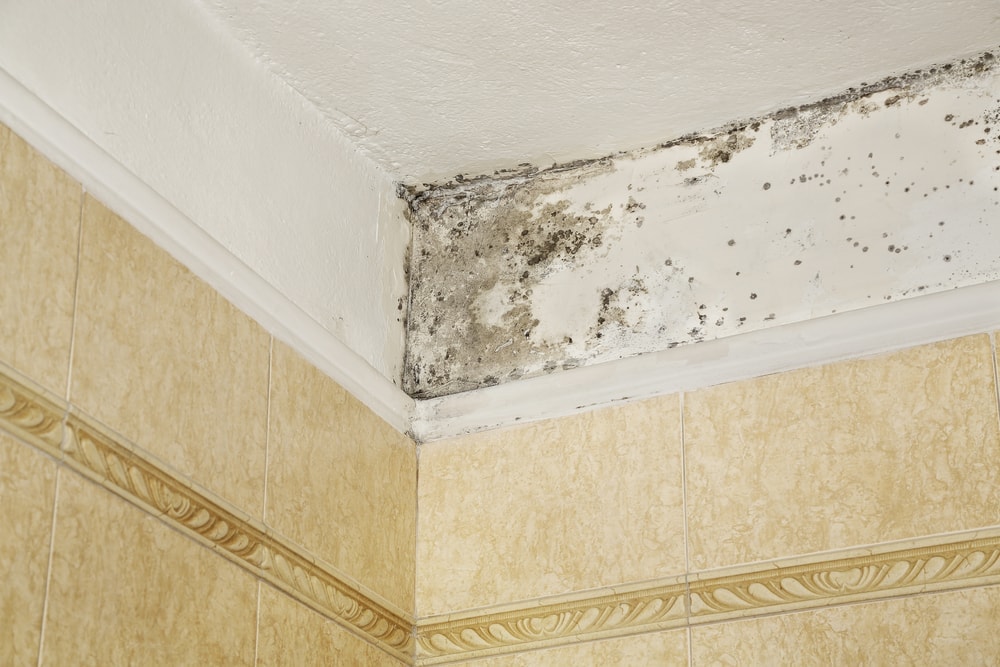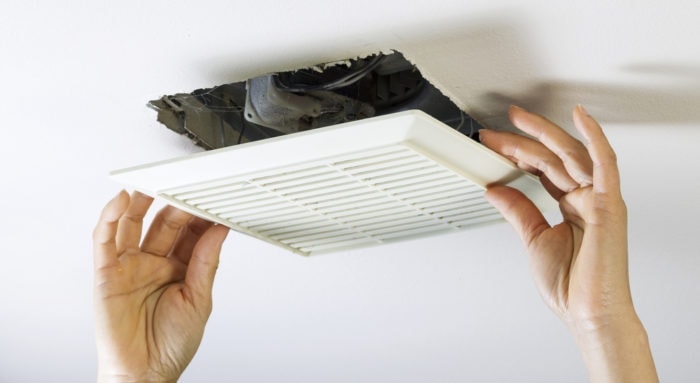This post may contain affiliate links. Please read the disclosure for more info.
When I first bought my home, we were going through the home inspection and me being my typical self I had to go along with the inspector to poke and prod at things I was seeing. When we got into the attic, I quickly noticed the smell, moisture and what I could see as mold on the roof rafters above each bathroom. After further inspection it was evident the current home owners vented their bathroom exhaust fans directly into the open attic space and not to the outside. I called a few friends and discussed the importance of this finding on my decision to purchase the home or not. I purchased the home and it took me about six months to repair the bathroom exhaust vents. Since we had more people living in the home than the previous owners, we saw an almost immediate increase in the mold in the attic and then in the bathrooms. I quickly needed to remediate this situation. I worked to properly vent the bathroom exhaust fans to the outside of my home through the roof!

So, can you vent a bathroom exhaust fan into the attic?
No, you cannot vent your bathroom exhaust fan into the attic. You should never exhaust the bathroom fan directly into the attic. Your attic is not a temperature-controlled environment, is never the same temperature as your living space and generally closer to the temperature outside. What this means is that in colder weather, the vented air with moisture in the air will mix with the attic air causing condensation to form due to the warm air from the bathroom and it doesn’t have to be freezing for this to occur, however, just cool enough fall below the dewpoint. At that point the amount of moisture results in the formation of water droplets on the roof rafters, ceiling joists, and drywall. Once this happens it is almost a certainty for mold to follow causing rafters and joists to rot and over time possibly collapse from the weight of the roof! It is almost always required by code that the exhaust fans vent on the outside of the home with no air leaks into the interior of the home. Take the time to ensure the bathroom exhaust vent is done properly. This can be achieved by following building codes, providing the exhaust fan it’s a path to the outside of your home by installing a roof vent, or installing a capped vent to the side of your home.
So why do you need a bathroom exhaust fan, what bathroom exhaust fan should you choose and why? To learn more continue reading below.
Jump To:
Why do you need a bathroom exhaust fan? What does it do?

You need a bathroom exhaust fan to help the humid air from your bathroom (or kitchen) leave your home in the most direct route to the outside without mixing with the air in your attic or walls causing condensation. If you allow the air from your bathroom exhaust fan to mix with the air in your attic (which is usually the same as the outside temperature) it can cause condensation, wetting the wood, allowing for mold growth and over time weakening the structure of your home while causing possible health issues for your family. Keep in mind that venting the bathroom exhaust fan outside is not enough, you need to make sure it is venting in the proper way.
Since you cannot vent a bathroom exhaust fan into the attic what are your options?
The best way to do it is to give the bathroom exhaust fan its own direct vent to the outside of your home and not into the attic where it can mix with the air causing the issues mentioned above.
Can you vent a bathroom exhaust fan into the soffit vents?
No, you cannot vent the bathroom exhaust fan into the soffit vents. If you vent the bathroom exhaust fan to close to the soffit vents, which are vented plates under your homes outer edge and roof, your home the air can be sucked right back into the attic from the soffit. If you put the bathroom exhaust vent to close to the soffit vents it will get drawn back into the attic where it will condense and have the same issues occur as above.
What do I look for when selecting a bath fan?
In most cases you will select the bathroom exhaust fan based on noise level, style, and performance. First and most important is the air movement capacity which is measure in cubic feet per minute or CFM. As a rule of thumb most bathroom air movement capacity rates will work out to be one CFM per square foot of bathroom area. For example, an 8’ x 5’ bathroom would require a 40 CFM exhaust fan, however a 50 CFM rating is recommended as a minimum for all bathrooms under 50 square ft. Larger bathrooms will require more ventilation capacity.
Let’s review the chart as a guide:
| Bathroom Square Feet | Bathroom CFM Rating (min) |
| Less than 50 square feet | 50 CFM |
| 50 – 100 square feet | 1 CFM per square foot |
| Greater than 100 square feet | Add the CFM required for each fixture: |
| * Toilet, Shower, Bathtub add 50 CFM each | |
| * Jetted tub adds 100 CFM |
*Note: These are the minimum requirements. Higher ventilation rates are acceptable.
What other factors can impact bathroom ventilation?
There are several other factors to consider for proper ventilation such as:

• An enclosed toilet would require its own exhaust fan
• Exhaust fans approved for installation in wet areas would need to be located over (or near) the shower or tub
• Bathroom doors should have at ¾” clearance to the floor to allow for proper air flow
• A bathroom with greater ceiling higher than 8′ would require additional ventilation
• Noise level – don’t overlook this one! It can drive you crazy! Noise level or sones are an important consideration when choosing a bathroom exhaust fan. Since sones are the measurement that tells you how loud the fan will be, a fan with 2 sones or less is considered quiet. I believe next to the air movement this is more important since you spend time in the bathroom and the last thing you want to listen to is the sound of a fan humming. Additionally, some larger CFM bathroom exhaust fans are so noisy no one wants to operate them resulting in moisture, mold and rot issues. Be sure to review the table above for the right CFM rating required for your bathroom and ensure you choose the bathroom exhaust fans with a sones level that is 2 or less.
• Bathroom ventilation is also important to remove any VOC’s from the room based on aerosol use and other personal hygiene products.
Why is ventilation important?

We all enjoy a healthy and comfortable environment within our homes. This occurs by proper ventilation to help remove excess moisture in the air that can lead to air pollutants that can affect your overall health.
If the ventilation is neglected over time the home and health can both suffer. With excess moisture you can start to have allergies and your home can be effect by structural issues due to mold, dust mites, dry rot, insects and more.
Keep your homes ventilation in check and enjoy proper air quality and long term home structural integrity.
How much does it cost to install a bathroom vent?
- A bathroom exhaust fan on average will cost $425 with a range from $250 – $700
- The fan itself can cost from $35 – $350 and installation can be $175 – $350
Can you vent a bathroom fan into plumbing vent?

NO!! You have a serious risk of venting sewer gasses into your home. Sewer gas can be explosive, not to mention likely to be unpleasant and possibly unhealthy.
Second is that a drain vent is typically too small and too moist to properly vent a bathroom fan. Most exhaust fans are designed to use a 4″ duct, and instead it’s going through a 1.5″ diameter pipe. If any lint or dust gets pushed out by your exhaust fan, it risks accumulating on the inside of the vent pipe, possibly blocking slowing both the drainage and ventilation.
Beside the problems listed, you’ll also have a visible issue that anyone inspecting your attic will see. You should ensure you install a proper-sized duct with direct roof ventilation and avoid impacting your drain vent pipe.

